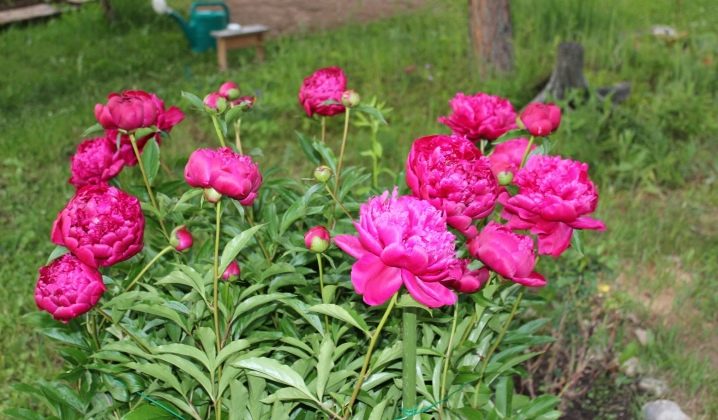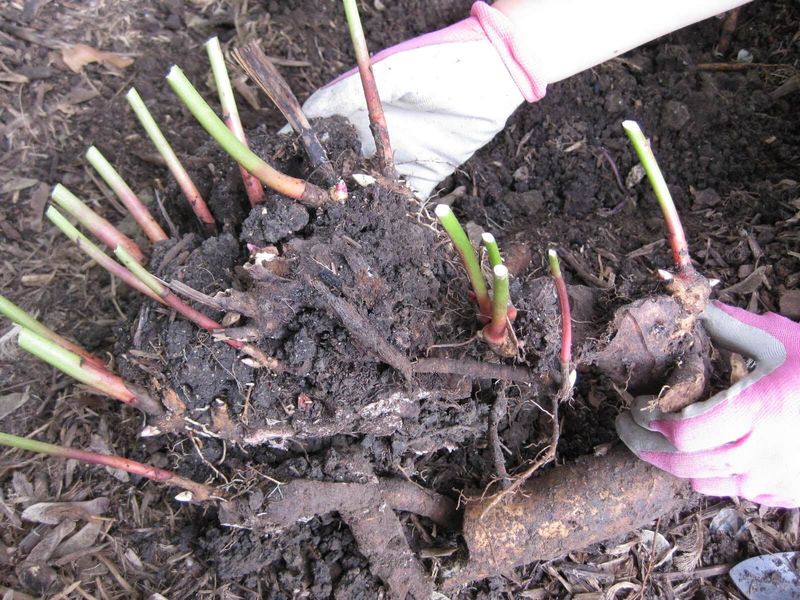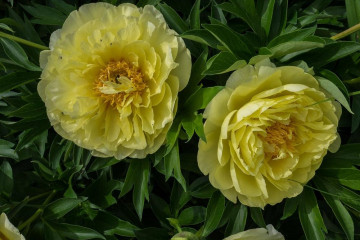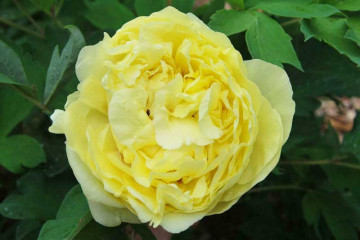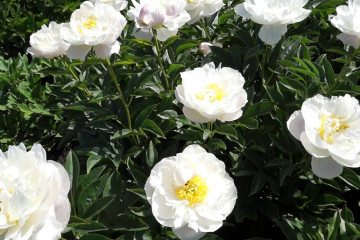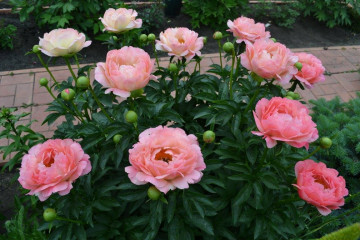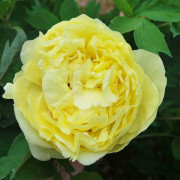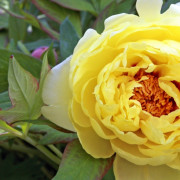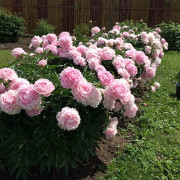Peony Felix Krauss (Paeonia Felix Crousse - planting and care
Content:
Bred in 1881 in France, the herbaceous peony continues to delight the eye today. The peony retains its aesthetic appearance even after flowering stops. A flower is planted in flower beds or rectangular flower beds, near the house or plots are zoned with it.
Peony Felix Krauss (Paeonia Felix Crousse) - what is this variety, history of creation
The Felix Krauss variety is one of the most resistant to low temperatures, it fits perfectly into any decorative composition. Has the following description:
- height - 90 cm;
- flowering time begins in mid-July;
- flower diameter about 17 cm;
- Terry flower, red with a purple tint;
- the aroma is pleasant, slightly perceptible;
- leaves and stem are dark green.
Designers often use this variety, it looks great in the form of bushes on the lawn and gets along well with other perennials.
Growing a flower, how to plant it in open ground
Most often, this variety is planted using cuttings, since the seeds rarely take root.
Planting by root cuttings
The process itself is quite simple - you need to separate several cuttings with roots and buds from the mother plant. In this case, the mother plant must be at least 3 years old.
When a peony is planted
Planting of the variety is recommended from August to mid-September. If later, then the plant simply will not have time to take root in a new place and will die during the first frosts. Gardeners often plant a flower in the spring, although this is not recommended.
How to choose a seat
Since Felix Krause is a fairly thermophilic flower, he will feel great in a sunny area protected from the wind. The soil is of no small importance - it must be loose enough and have neutral acidity.
Adult plants grow strongly in breadth, so 1.5 meters of free soil is left between the plots. Otherwise, due to the overgrown root system, neighboring plants will not be able to receive normal nutrition and air access. This leads to the appearance of rot and various diseases.
How to prepare the soil and flower for planting
To make the soil suitable for planting, it is dug up and river sand and humus are added to make it loose enough and enrich it with nutrients.
Planting procedure step by step
Like all cultivated plants, the lactic-flowered peony Kruss must be planted according to certain rules:
- Dig a hole 60 cm deep and 50-60 cm wide.
- A thin layer of rubble is poured onto the bottom.
- Prepare the soil: mix peat, humus, soil from the site and sand in equal parts - and fall asleep in the pit.
- Form a small depression.
- A cutting is placed in it and the roots are straightened, being careful not to damage them.
- Sprinkle the cutting with earth: the lowest buds of the plant should be sprinkled with it.
- After planting, the peony is watered, and the ground around it is sprinkled with chopped dry grass.
Is it possible to grow a peony from seeds
Growing a peony from seeds is difficult. But for breeding purposes it's worth a try. To do this, follow the recommendations:
- seeds for planting are selected unripe and planted until they are dry;
- seeds are sown into the ground to a depth of 5 cm and placed in the cold (you can put it in the refrigerator);
- the seedlings that appear are transplanted into the soil after 2 years.
How to care for a plant
Felix Krauss bushes do not require special care. Like any other plants, they need to be watered, fertilized, and dug up near the roots. Then the plant will delight you with abundant flowering.
Watering and feeding
The plant is watered as the soil dries up. But as the flowering time approaches (late May - early June) and the laying of new buds (mid-August - early September), watering needs to be increased. Once a week, the plant is watered with 15-20 liters of water.
Peony feeding is carried out twice a year. In the spring they are fed with urea or saltpeter for weight gain, in the fall - with nitrogen-free fertilizers.
Loosening and mulching the soil
When the soil dries slightly after moistening (rain or watering), it must be slightly loosened to a depth of 2 cm. Weeds must be removed from the roots. In the spring, the bush is sprinkled with chopped manure.
Prevention of diseases and pests
During flowering, the pleasant scent attracts many insects to the flower. To protect the bush from the invasion of pests, in the spring the leaves and the stem are sprayed with special preparations (Fitosporin-M) or a weak solution of potassium permanganate. You can also water the soil with a solution of copper sulfate.
Peony Blossom Felix Krause
Felix Krauss is characterized by abundant and long flowering. Depending on the region, the bush begins to bloom in late June - mid-July. The process lasts a month.
Leaving during flowering
In order for the flowering bush to delight with its beauty as long as possible, gardeners need to remove all faded buds. This will save the plant from diseases. They act carefully: only wilted flowers are removed, the stems themselves remain in place, otherwise the buds that have not yet opened can be damaged.
What to do if the peony does not bloom
If the peony does not release flowers for a long time, this may be evidence of violations or illness of the bush. Common reasons for the lack of flowering:
- lack of sunlight;
- soil acidity - most often increased;
- incorrect pruning;
- insufficient feeding or lack of it;
- pests;
- plant disease.
Most often, the problem of flowering is solved very simply - the peony is transplanted to another area and the care for it is adjusted.
How to care for a plant after flowering
After flowering, the peony Felix Krause begins to recover and form new buds, from which new stems will appear in the spring. During this period, active preparation for winter begins.
How to transplant a bush
It is better to transplant the Felix Krauss bush from late August to mid-September. Later, it is undesirable, since the plant may not have time to take root before the onset of cold weather. Transplant procedure step by step:
- Weather conditions are important for transplanting - it must be dry and warm.
- The leaves are cut to a height of 15-20 cm.
- The plant is removed from the soil along with the root ball, without removing the soil from the roots.
- When transplanting, the same conditions are met as when planting cuttings.
Do I need to prune a peony for the winter
For a peony, pruning for the winter is very important. The bushes are pruned in the fall (October - early November). If done later, the roots will rot and the plant will die.
How to prepare a flower for winter
Although this variety is frost-resistant, it is still recommended to sprinkle the plant (especially a young one) with earth and humus, and also cover it with dense material. In the spring, be sure to remove all shelters and embankments to give the roots access to air and not limit the evaporation of moisture.
Pests and diseases: how to deal with them
Most often, the bush is attacked by pests during flowering, but this can happen in another period. Most often, gardeners are faced with the following pests:
- bronze;
- aphid;
- ants;
- thrips.
It is not difficult to scare off these pests: the bush is sprayed with insecticides or folk remedies, such as potassium permanganate and copper sulfate. The plant is quite well protected from diseases by natural immunity. In some cases, the following diseases may appear:
- gray rot - a brown ring appears at the bottom of the stem, with the progression of the fungal disease, the stem breaks off;
- rust - brown and yellow spots appear on the leaves, and on the underside - a fungus with spores;
- ring mosaic - spots and rings appear on the leaves.
Fight disease as follows:
- First of all, all infected areas are removed, the sections are sprinkled with wood ash or crushed activated carbon.
- The rest of the bush is sprayed with preparations containing copper, such as copper sulfate. You also need to water the soil, many diseases can remain in it.
- All nearby plants are treated with fungicides, for example, foundationol or nitrofen.
Peonies are one of the most beautiful flowers in the garden. To make them pleasing to the eye, you need to properly care for them and protect them from diseases and pests.
